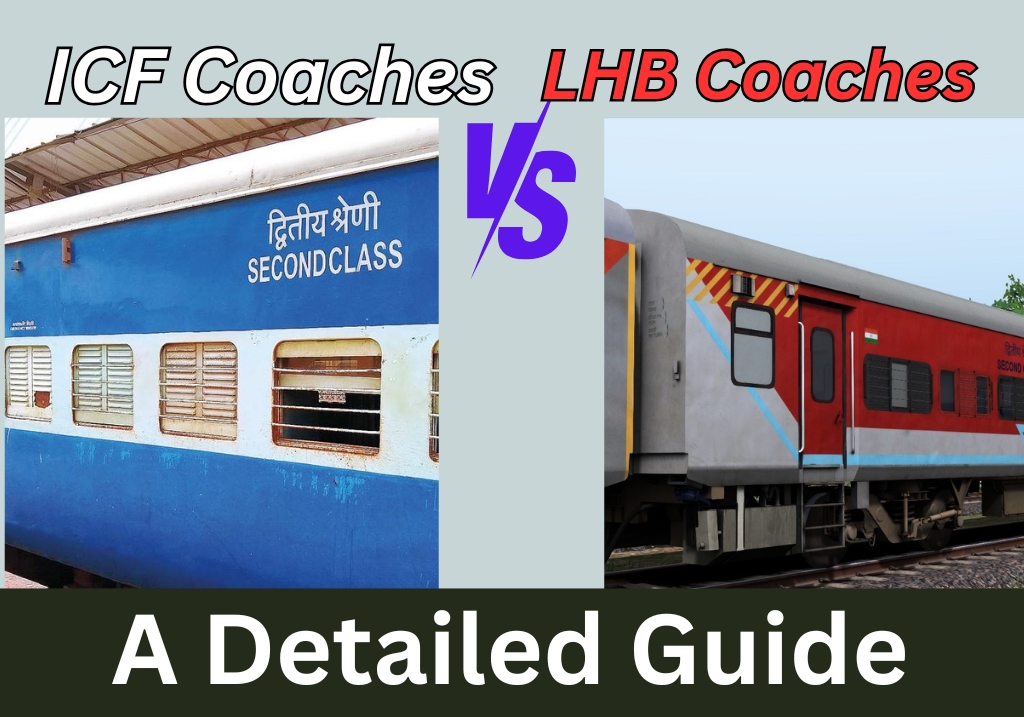When you board a train in India, have you ever wondered about the type of coach you’re traveling in? Indian Railways uses two primary types of coaches: ICF (Integral Coach Factory) and LHB (Linke Hofmann Busch). While both serve the same purpose, they differ significantly in design, safety, speed, and comfort.
In this blog, we’ll dive deep into the ICF Coaches vs LHB coaches debate, exploring their features, pros and cons, and why Indian Railways is gradually phasing out ICF coaches in favor of LHB. Whether you’re a curious traveler or a rail enthusiast, this guide will help you understand what makes these coaches unique.
What Are ICF Coaches?
In the comparison of LHB coaches vs ICF coaches ICF stands for Integral Coach Factory, a manufacturing unit in Chennai that has been producing railway coaches since 1955. ICF coaches are known for their robust design and cost-effectiveness, making them a staple in Indian Railways for decades.
Key Features of ICF Coaches
- Design: Screw-coupled system with a mild steel body.
- Speed: Maximum speed of 110–130 km/h.
- Safety: Basic safety features, prone to telescoping during accidents.
- Comfort: Basic suspension system, leading to a bumpy ride.
- Weight: Heavier (45–50 tons), resulting in higher fuel consumption.
Trains Using ICF Coaches
- Mumbai CSMT–Howrah Mail
- Gitanjali Express
- Many passenger and local trains
What Are LHB Coaches?
LHB stands for Linke Hofmann Busch, a German design adopted by Indian Railways in the 1990s. LHB coaches are modern, lightweight, and designed for higher speeds and better safety.
Key Features of LHB Coaches
- Design: Centre buffer couplers with a stainless steel body.
- Speed: Maximum speed of 160 km/h.
- Safety: Anti-climbing design, reducing the risk of telescoping.
- Comfort: Advanced suspension system for a smoother ride.
- Weight: Lighter (35–40 tons), improving fuel efficiency.
Trains Using LHB Coaches
- Rajdhani Express
- Shatabdi Express
- Duronto Express
- Express, Super fast
ICF vs LHB Coaches: Key Differences
Here’s a detailed comparison of ICF and LHB coaches:
| Feature | ICF Coaches | LHB Coaches |
| Design | Screw-coupled, mild steel body. | Centre buffer couplers, stainless steel. |
| Speed | Up to 130 km/h. | Up to 160 km/h. |
| Safety | Prone to telescoping. | Anti-climbing design, safer in derailments. |
| Comfort | Basic suspension, bumpy ride. | Advanced suspension, smoother ride. |
| Weight | Heavier (45–50 tons). | Lighter (35–40 tons). |
| Cost | Cheaper to manufacture. | More expensive to manufacture. |
Pros and Cons of ICF and LHB Coaches
ICF Coaches
- Pros:
- Affordable to manufacture and maintain.
- Simple technology, easy to repair.
- Widely used in Mail/Express and local trains.
- Cons:
- Less safe during collisions.
- Bumpy ride quality.
- Slower speed compared to LHB coaches.
LHB Coaches
- Pros:
- Safer due to anti-climbing design.
- Smoother ride with advanced suspension.
- Higher speed potential (up to 160 km/h).
- Cons:
- Expensive to manufacture.
- Limited availability compared to ICF coaches.
Why Are LHB Coaches Replacing ICF Coaches?
Indian Railways is gradually phasing out ICF coaches for several reasons:
- Safety: LHB coaches are designed to prevent telescoping during accidents.
- Speed: LHB coaches can operate at higher speeds, aligning with India’s goal of faster trains.
- Comfort: Passengers prefer the smoother ride offered by LHB coaches.
- Modernization: LHB coaches are part of Indian Railways’ plan to upgrade its fleet.
Current Status of ICF and LHB Coaches
- ICF Coaches: Still used in many Mail/Express and passenger trains, but their numbers are declining.
- LHB Coaches: Increasingly used in premium trains like Rajdhani, Shatabdi, and Duronto.
- Future Plans: Indian Railways aims to replace all ICF coaches with LHB and Vande Bharat coaches by 2030.
FAQ About ICF and LHB Coaches
Q1. What is the full form of ICF and LHB?
- ICF: Integral Coach Factory.
- LHB: Linke Hofmann Busch.
Q2. Which is safer: ICF or LHB coaches?
- LHB coaches are safer due to their anti-climbing design.
Q3. Why are LHB coaches faster than ICF coaches?
- LHB coaches are lighter and have better suspension, allowing higher speeds.
Q4. Are ICF coaches still used in Indian Railways?
- Yes, but they are being phased out gradually.
Q5. Which trains use LHB coaches?
- Rajdhani, Shatabdi, Duronto, and other premium trains.
Conclusion
The ICF vs LHB coaches debate highlights the evolution of Indian Railways. While ICF coaches have served the nation for decades, LHB coaches represent the future—offering better safety, speed, and comfort. As Indian Railways continues to modernize, understanding these differences can help passengers make informed travel choices.
Next time you board a train, take a moment to notice the type of coach you’re in. Whether it’s the sturdy ICF or the modern LHB, each has its own story to tell.
For more insights into Indian Railways, stay tuned to Your Railway Guide!

